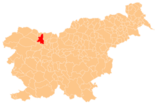Radovljica
| Radovljica | |||
|
|||
| Basic data | |||
|---|---|---|---|
| Country |
|
||
| Historic region | Upper Carniola / Gorenjska | ||
| Statistical region | Gorenjska (Upper Carniola) | ||
| Coordinates | 46 ° 20 ′ N , 14 ° 10 ′ E | ||
| surface | 118.7 km² | ||
| Residents | 18,664 (2008) | ||
| Population density | 157 inhabitants per km² | ||
| Post Code | 4240 | ||
| License Plate | KR | ||
| Structure and administration | |||
| Mayor : | Janko Sebastijan Stušek | ||
| Website | |||
Radovljica ( German : Radmannsdorf ) is a municipality and city in the Gorenjska region in Slovenia .
Location and inhabitants
Around 18,664 people live in the total community, which consists of 52 localities and hamlets. The city of Radovljica alone has 5937 inhabitants and is located 6 km from Bled at the confluence of the Wurzener Sava and the Wocheiner Sava to the Sava .
history
The place was first mentioned in 1296. After an economic boom in the Middle Ages, the economic decline began in the 18th century. This prevented further modernization. Therefore, many historical buildings have been preserved in the old town. The place is also known for the beekeeping museum in the old town. Until the end of the Habsburg Empire, the city belonged to the Kronland Carniola , with Radovljica forming an independent municipality in the judicial district of Radmannsdorf (political district Radmannsdorf ) and the seat of the district court and the district administration.
In the district of Begunje , the Kamen Castle is worth seeing. In Kropa you can see one of the oldest surviving melting furnaces in Europe. The district was an important place for an iron forge as early as the 14th century. Kropa has been a technical and cultural national monument since 1953 .
Community structure
The Radovljica municipality is divided into the following localities:
- Begunje (German Vigaun )
- Brda (German corners near Siedendorf )
- Brezje (German Pirkendorf )
- Brezovica (German Bresowitz )
- Dobravica (German Hartel )
- Dobro Polje (German Gutenfeld )
- Dvorska vas (German Hofdorf in the Upper Carniola )
- Češnjica pri Kropi ( Eng . Kerschdorf )
- Črnivec (German Schwarzenbach )
- Globoko (German Globokau )
- Gorica (German Görtz )
- Hlebce (German Clebitz )
- Hraše (German Hrasche )
- Kamna Gorica (German Steinbüchel in the Upper Carniola )
- Kropa (German Siedendorf )
- Lancovo (German Lanzau )
- Lesce (German Lansdorf )
- Lipnica (German: Kleinsaifnitz )
- Ljubno (German Lauffen )
- Mišače (German Mischatsch )
- Mlaka (German moss under the mountains )
- Mošnje (German Möschnach )
- Nova vas pri Lescah (German Neudorf )
- Noše ( Eng.Noschach )
- Otoče (Slovenia) (German: Groß Ottock )
- Ovsiše (German Haberlandt )
- Peračica (German Piraschitz )
- Podnart (German Gerschdorf )
- Poljče (German Pöllitisch )
- Poljšica pri Podnartu (German Pogelschitz )
- Posavec (German Posautz )
- Praproše (German Praprotschdorf )
- Prezrenje ( Eng . Pressrein )
- Ravnica (German Raunitz )
- Rovte (German Gereuth )
- Slatna (German Dobrian )
- Spodnja Dobrava (German Niederhardt )
- Spodnja Lipnica (German Lower Leifnitz )
- Spodnji Otok (German lower value )
- Srednja Dobrava (German Mitterhardt )
- Srednja vas (German Mitterdorf )
- Studenčice (German: Kaltenbrunn )
- Vošče ( Eng . Laschitz in the Upper Carniola )
- Vrbnje (German Werblach )
- Zadnja vas
- Zaloše (German Galloschach )
- Zapuže (German Sappelschach near Untersauenstein )
- Zgornja Dobrava (German Oberhardt )
- Zgornja Lipnica (German Upper Leifnitz )
- Zgornji Otok (German upper value )
- Zgoša (German Güsch )
Thurn Castle
The medieval castle in the middle of Linhart-Platz was built by the county of Ortenburger . When it came into the possession of the Habsburgs along with the city , they rented everything together to various noble families. The castle was thoroughly rebuilt after the earthquake of 1511 and enlarged in the 17th century for the Count of Thurn-Valsassin . In the middle of the 18th century a large staircase with an oval anteroom was built and the facade was given rich stucco figures. Today the castle houses the administration of the Radovljica Municipality Museums (Beekeeping Museum and Šivec House in Radovljica, Hostage Museum in Begunje, Blacksmithing Museum in Kropa). The Slovenian Central Beekeeping Museum is particularly important; With a rich collection, it presents the development and importance of beekeeping in Slovenia, which A. Janša made known in Europe in the 18th century as an outstanding specialist in bees and beekeeping . In the museum there is also a collection of old beehive decorations (mostly humorous painted beehive front boards) from the 18th and 19th centuries, which are a specialty of Slovenian folk art. In the castle there is also a Linhart memorial room , where you can see the work of the historian and playwright Anton Tomaž Linhart .
Personalities
- Anton Tomaž Linhart (1756–1795), playwright, poet, historian and scholar
- Laurenz Janscha (1749–1812), graphic artist, born in Rodin
- Anton Dermota (1910–1989), lyric tenor, born in the Kropa district
- Pavel Šivic (1908–1995) composer
- Wolfgang Marchart (1945–2008), district captain in Klagenfurt
- Matej Jovan (* 1970), ski racer
Twin cities
Web links
- Website of the municipality in Slovene and English



